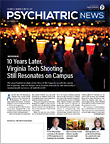What is the effect on a young person of being told—by teachers, peers, family members, or clinicians—that he or she is “at risk” of psychosis or schizophrenia?
What kind of experiences does that young person bring to treatment in early intervention programs? How do those experiences affect treatment adherence and recovery? And how can the movement toward early identification and intervention incorporate strategies to address the potential stigma attached to being “at risk”?
Those are some of the questions being explored in research by Lawrence Yang, Ph.D., an associate professor of social and behavioral sciences at New York University; Larry Seidman, Ph.D., a professor of psychology in the Department of Psychiatry at Harvard Medical School; and William McFarlane, M.D., professor of psychiatry at Maine Medical College. Seidman is the principal investigator of the high-risk intervention program at Beth Israel Deaconess Medical Center (affiliated with Harvard Medical School), which is part of the North American Prodrome Longitudinal Study (NAPLS), a consortium of nine sites compiling longitudinal data on individuals deemed to be at clinical high risk (CHR) for psychosis.
Their study, “Predictors of Being ‘Most Impacted’ by Psychosis in Self-Identity Among Individuals at Clinical High-Risk for Psychosis,” is looking at factors affecting stigma and self-identity among 120 individuals being treated at three early identification/intervention sites—Beth Israel Deaconess Medical Center, the Portland Identification and Early Referral Program (PIER) in Portland, Maine, and Columbia University/New York Psychiatric State Institute in New York. (The last two are not a part of the NAPLS consortium.)
Yang presented baseline data from the study at the International Congress on Schizophrenia Research in San Diego in March. Notably, close to two-thirds of the sample (n=63) had been told that they were at risk for psychosis or schizophrenia.
Perhaps most significant for future research and intervention strategies, the factor that is most predictive of individuals’ considering themselves “most impacted” by psychosis is being told that they are at risk for psychosis/schizophrenia That is, being labeled by others (as opposed to what individuals identified as high risk might think of themselves) appears to be a critical factor in self-identity and one that elevates the impact of the label of “at-risk for psychosis/schizophrenia.”
(Yang and Seidman explained that “impactfulness,” in the context of the survey, refers to whether the designation of “at risk” affected how the individual thinks about himself or herself and the need to make changes or adjustments in response to a label.)
“For clinicians working in specialty clinics for individuals identified as high-risk patients, it’s important to gauge with whom they have been in contact and what those individuals might have told them,” Yang told Psychiatric News at the Congress. “The patient may bring those ideas and attitudes into treatment. Clinicians should be aware of that and prepared to offer some psychoeducation around those issues.”
Seidman said the research points to the fact that the subjective experience of being at risk is largely a black box: How does that experience affect participation in treatment and recovery? And can how early intervention programs use this knowledge to address stigma as a part of treatment?
“There’s a real need for greater understanding on the part of clinicians about the variety of ways people think about these symptoms, and there is a lot of work to be done in developing anti-stigma strategies that could be part of the clinical high-risk intervention strategy,” he said.
Surprisingly, while a third of the sample rated themselves “most impacted” by the “risk” label for psychosis/schizophrenia, two-thirds rated themselves most impacted by other, nonpsychotic condition labels—especially anxiety and depression.
Yang and Seidman suggested that the finding relates to the fact that nearly all individuals being treated in high-risk clinics have a long history of wrestling with mental health problems and may be likely to subsume information about their risk for psychosis into that history of other problems.
Moreover, they said, young people are likely to be subjectively more concerned with concrete problems in their daily lives—school work and being able to function in social situations—than with a future risk of psychosis. “The subjective complaints of high-risk patients are likely to be about cognitive problems—‘I can’t think, I can’t concentrate, I can’t do my schoolwork,’ ” Seidman said.
Further research on self-identity and stigma among the CHR population may prove crucial. Concerns about stigma and false-positives were important factors in debates about whether to include criteria for “clinical high risk syndrome” in the main text of
DSM-5. While these criteria identifying individuals at clinical high risk can reliably predict conversion to acute psychosis approximately 30 percent of the time, many youth will never convert but will continue to have sub-syndromal symptoms.
Much recent research revolves around how to refine prediction of outcome among individuals deemed to be at risk of psychosis.
Yang and Seidman said that issues of stigma and self-identify are vital clinical issues, and the totality of experience that young people bring to treatment in an early intervention clinic is likely to affect their attitude toward recovery and their trajectory and outcome.
“These individuals may have been bullied in school or ridiculed, or they may have had good or bad experiences with mental health clinicians,” Seidman said. “At least 80 percent of individuals in clinical high-risk clinics have already had some experience with mental health treatment. If clinicians face these labels and descriptions about being at risk for psychosis or schizophrenia with empathy, and teach people about what they mean and don’t mean, it’s possible to have a much better outcome than if clinicians simply ignore it and pretend the problem is not there.” ■

